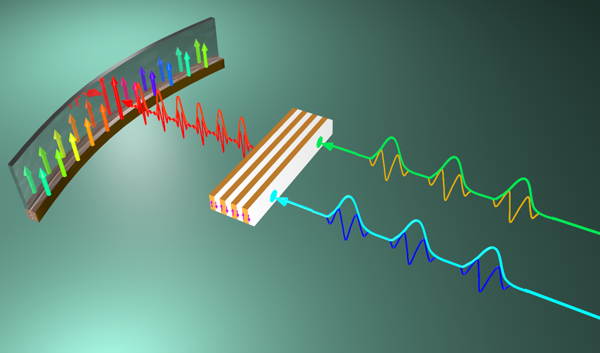An optical frequency comb can be used as an optical ruler for the measurement of absolute optical frequencies. The precision of spectroscopy has been revolutionized using comb technology. To improve the comb spectroscopy sensitivity, using mid-infrared combs has become popular in recent years because of strong vibrational absorption in the mid-infrared region.
There is a wide array of innovative solutions to generate coherent mid-infrared laser sources, with novel gain media, quantum cascade lasers, and micro-resonator, supercontinuum generation in the waveguides and the fibers. Compared with these approaches, detecting and controlling the offset frequency of mid-infrared sources is a challenging work, which is the prerequisite for frequency comb spectroscopy.
A more direct approach is to employ nonlinear frequency conversion of ultrashort pulses in visible or near-IR regime to generate coherent mid-infrared sources. Difference frequency generation (DFG) employing signal and pump delivered from the same oscillator offers several advantages for a mid-infrared frequency comb system. It allows us to use compact and well-developed fiber laser technology and to achieve ultrashort pulses and intrinsic carrier-envelope phase stability. Moreover, this approach reduces complexity and improves quality of long-term performance. The linewidth of mid-infrared comb generated by DFG is related to the near-infrared source' s phase noise.
Compared to the mid-infrared combs, the near-infrared combs are easier to measure and control phase noise. Therefore, low phase noise of two near-infrared sources is fundamental to achieve high-resolution dual-comb spectroscopy. Various ultralow-noise near-infrared oscillators have been demonstrated. Excess phase noise from near-infrared amplification and DFG process will lead to linewidth broadening of the mid-infrared comb.
The group led by Prof. Wenxue Li from East China Normal University researched noise source of DFG-based mid-infrared comb. The research results are published in High Power Laser Science and Engineering 8(4), e32, 2020 (Lian Zhou, Yang Liu, Gehui Xie, et al. Mid-infrared optical frequency comb in the 2.7–4.0 μm range via difference frequency generation from a compact laser system[J]. High Power Laser Science and Engineering, 2020, 8(4): 04000e32).
The article reports on a mid-infrared comb based on a near-infrared system. The near-infrared system included an Yb:fiber comb and an Yb fiber chirped-pulse amplifier emits a pulse train with a 4-W average power and a 194-fs pulse duration. The near-infrared source is spilt into two beams as signal and pump pulse of DFG.
The spectrum of signal pulse is nonlinearly broadened in highly nonlinear photonics crystal fiber with anomalous dispersion. The pump and signal pulse are focused into a periodically poled lithium niobate for DFG. The mid-IR comb has a tunable spectrum from 2.7 μm to 4.0 μm and a maximum average power of 250 mW. Authors measured noise of each module and analyzed noise source. The phase noise of repetition rate in the offset-free mid-IR comb system is measured and analyzed.
Except for the intrinsic of NIR comb, environmental noise at low frequency and quantum noise at high frequency from the amplifier chain and nonlinear spectral broadening are the main noise source of broadening the linewidth of comb teeth. Prof. Wenxue Li believes that this work is potential to develop low-noise mid-infrared combs and high-coherence dual-comb spectroscopy.

Mid-infrared comb generation via difference frequency generation.


